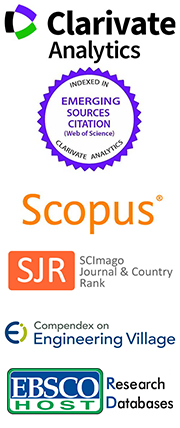Techno-Economic Optimization of Cellulose Corrugated Pads for Evaporative Cooling Systems Using the Net Saving Method
Abstract
Keywords
Full Text:
PDFReferences
Oropeza-Perez I. and P.A. Østergaard. 2018. Active and passive cooling methods for dwellings: A review. Renewable and Sustainable Energy Reviews 82: 531-544. doi: 10.1016/j.rser.2017.09.059.
Watt J.R. 1986. Evaporative Air Conditioning Handbook, 2nd ed. Boston, MA, USA: Springer US. doi: 10.1007/978-1-4613-2259-7.
Ghani S., Bakochristou F. ElBialy E.M.A.A., Gamaledin S.M.A., Rashwan M.M., Abdelhalim A.M., and Ismail S.M., 2019. Design challenges of agricultural greenhouses in hot and arid environments – A review. Engineering in Agriculture, Environment and Food 12: 48–70. doi: 10.1016/j.eaef.2018.09.004.
Al Assaad D.K., Orabi M.S., Ghaddar N.K., Ghali K.F., Salam D.A., Ouahrani D., Farran M.T., and Habib R.R., 2021. A sustainable localised air distribution system for enhancing thermal environment and indoor air quality of poultry house for semiarid region. Biosystems Engineering 203: 70-92. doi: 10.1016/j.biosystemseng.2021.01.002.
Xuan Y.M., Xiao F., Niu X.F., Huang X., and Wang S.W., 2012. Research and application of evaporative cooling in China: A review (I) – Research. Renewable and Sustainable Energy Reviews 16: 3535–3546. doi: 10.1016/j.rser.2012.01.052.
Ulpiani G., 2019. Water mist spray for outdoor cooling: A systematic review of technologies, methods and impacts. Applied Energy 254: 113647. doi: 10.1016/j.apenergy.2019.113647.
Pérez-Urrestarazu L., Fernández-Cañero R., Franco A., and Egea G., 2016. Influence of an active living wall on indoor temperature and humidity conditions. Ecological Engineering 90: 120–124. doi: 10.1016/j.ecoleng.2016.01.050.
Watson J.A., Gómez C., Bucklin R.A., Leary J.D., and McConnell D.B., 2019. Fan and pad greenhouse evaporative cooling systems. Univ. Florida IFAS Extension, 2019. [Online]. Available: https://edis.ifas.ufl.edu/publication/AE069
Franco A. and D.L. Valera. 2014. Energy efficiency in greenhouse evaporative cooling: Cooling boxes versus cellulose pads. Energies 7(3): 1427–1447. doi: 10.3390/en7031427.
Ahmed E.M., Abaas O., Ahmed M., and Ismail M.R., 2011. Performance evaluation of three different types of local evaporative cooling pads in greenhouses in Sudan. Saudi Journal of Biological Sciences 18(1): 45–51. doi: 10.1016/j.sjbs.2010.09.005.
Czarick M. and B. Fairchild. 2012. Plastic less effective than paper evaporative cooling pads! World Poultrymeat 28: 26–29.
Martínez P., Ruiz J., Martínez P.J., Kaiser A.S., and Lucas M., 2018. Experimental study of the energy and exergy performance of a plastic mesh evaporative pad used in air conditioning applications. Applied Thermal Engineering 138: 675–685. doi: 10.1016/j.applthermaleng.2018.04.065.
Liao C.M. and K.H. Chiu. 2002. Wind tunnel modeling the system performance of alternative evaporative cooling pads in Taiwan region. Building Environment 37: 177–187. doi: 10.1016/S0360-1323(00)00098-6.
Franco A., Valera D.L., Madueño A., and Peña A., 2010. Influence of water and air flow on the performance of cellulose evaporative cooling pads used in Mediterranean greenhouses. Transactions of ASABE 53(2): 565–576.
A. Malli, Seyf H.R., Layeghi M., Sharifian S., and Behravesh H., 2011. Investigating the performance of cellulosic evaporative cooling pads. Energy Conversion and Management 52(6): 2598–2603. doi: 10.1016/j.enconman.2010.12.015.
Doğramacı P.A., Riffat S., Gan G., and Aydın D., 2019. Experimental study of the potential of eucalyptus fibres for evaporative cooling. Renewable Energy 131: 250–260. doi: 10.1016/j.renene.2018.07.005.
Nada S.A., Fouda A., Mahmoud M.A., and Elattar H.F., 2019. Experimental investigation of energy and exergy performance of a direct evaporative cooler using a new pad type. Energy and Buildings 203: 109425. doi: 10.1016/j.enbuild.2019.109425.
Barzegar M., Layeghi M., Ebrahimi G., Hamzeh Y., and Khorasani M., 2012. Experimental evaluation of the performances of cellulosic pads made out of Kraft and NSSC corrugated papers as evaporative media. Energy Conversion and. Management 54: 24-29. doi: 10.1016/j.enconman.2011.09.018.
Naveenprabhu V. and M. Suresh. 2020. Performance enhancement studies on evaporative cooling using volumetric heat and mass transfer coefficients. Numerical Heat Transfer 7899): 504-523. doi: 10.1080/10407782.2020.1793556.
Elmsaad E.M.A.Y., Elnewiry O.A.M., and Ali M.A., 2017. Impact of different thicknesses of evaporative cooling pads on crop yield in greenhouse. International Journal of Agriculture Innovation and Research 5(5): 883–888.
Rashwan M.A., Al-Helal I.M., Al-Kahtani S.M., Alkoaik F.N., Fickak A.A., Almasoud W.A., Alshamiry F.A., Ibrahim M.N., Fulleros R.B., and Shady M.R., 2025. Performance evaluation of volcanic stone pad used in evaporative cooling system. Energies 18(8):1897. doi: 10.3390/en18081897.
Soponpongpipat N., Jaruyanon P., and Nanetoe S., 2010. The thermo-economics analysis of the optimum thickness of double-layer insulation for air conditioning duct. Energy Research Journal 1(2): 146–151. doi: 10.3844/erjsp.2010.146.151.
Soylemez M.S. and M. Unsal. 1999. Optimum insulation thickness for refrigeration applications. Energy Conversion and Management 40(1): 13-21.
Bishoyi D. and K. Sudhakar. 2017. Experimental performance of a direct evaporative cooler in composite climate of India. Energy and Buildings 153: 190-200. doi: 10.1016/j.enbuild.2017.08.018.
Stull R., 2011. Wet-bulb temperature from relative humidity and air temperature. Journal of Applied Meteorology and Climatology 50(11): 2267-2269.
Camargo J.R., Ebinuma C.D., and Silveira J.L., 2005. Experimental performance of a direct evaporative cooler operating during summer in a Brazilian city. International Journal of Refrigeration 28(7): 1124-1132. doi: 10.1016/j.ijrefrig.2004.12.011.
He S., Guan Z., Gurgenci H., Jahn I., Lu Y., Alkhedhair A.M., 2014. Influence of ambient conditions and water flow on the performance of pre-cooled natural draft dry cooling towers. Applied Thermal Engineering 66: 621–631. doi: 10.1016/j.applthermaleng.2014.02.070.
Kulkarni R.K. and S.P.S. Rajput. 2013. Comparative performance analysis of evaporative cooling pads of alternative configurations and materials. International Journal of Advance Engineering Technology 6(4): 1524–1534.
Sonntag D.B., Jung H., Harline R.P., Peterson T.C., Willis S.E., Christensen T.R., and Johnston J.D., 2024. Infiltration of Outdoor PM2.5 Pollution into Homes with Evaporative Coolers in Utah County. Sustainability 16(1): 177. doi: 10.3390/su16010177.
Itani M., Ghali K., and Ghaddar N., 2015. Increasing energy efficiency of displacement ventilation integrated with an evaporative-cooled ceiling for operation in hot humid climate. Energy and Buildings 105: 26-36. doi: 10.1016/j.enbuild.2015.07.045.
Martínez P.J., et al., 2024. Analytical modelling of an indirect evaporative cooler based on the M-cycle,” in Proc. CYTEF 2024, XII Congreso Ibérico de las Ciencias y Técnicas del Frío, 2024.
National Renewable Energy Laboratory (NREL), 2012. Development and analysis of a desiccant-enhanced evaporative air conditioner prototype. NREL/TP-5500-54755.
Ghoname M.S., 2020. Effect of pad water flow rate on evaporative cooling system efficiency in laying hen housing. Journal of Agricultural Engineering 51(4). 213–218.
DOI: https://doi.org/10.64289/iej.25.03A11.1208787


